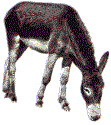HOME | home
Donkeys | Donkey Lore | Donkeys at Thistledown | John, the Farrier Comes | Morgan Horses | Horse Health | Horse Thieves | Driving Horses
 Donkeys
Donkeys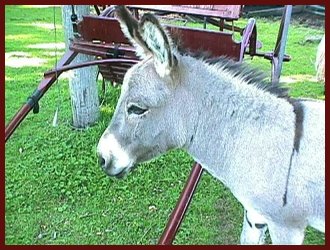
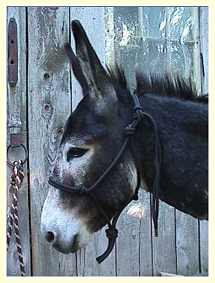
Thistledown's Billy Bagpipes, mini and Thistledown's Sassafras Sam, standard
History
All donkey stock originated in Africa where wild asses were first domesticated thousands of years ago. The Romans did much to spread the use of donkeys as beasts of burden throughout their empire and beyond. No one knows when the first donkeys reached China and India but they are used in great numbers in the Middle and Far East. Of the developed nations of Europe, Greece probably leads in using donkeys for serious work. Problems of transport on its many islands and rocky coasts have kept donkeys in the Greek Isles an important economic necessity. Even today, donkeys are ridden and packed all over Greece. Spain, Portugal, and Italy still have working donkeys as well but not in as great numbers. Donkeys are used on the Westbank and throughout the Middle East and are still bred in large numbers there as well. Iraq, Iran and Turkey all have large numbers of donkeys in service.
Donkey Stock at some point very long ago was taken to the Mediterranean islands of Sardinia and Sicily to be beasts of burden. These Islands are just off the coast of Italy. The Mini Donkeys in the USA today are mostly descended from this stock through a single importation in the 20s. The small size of the donkeys of Sicily and Sardinia more than likely resulted from selection for small size due to the small land mass of the Islands. Islanders had limited space and feed. It is not unlike the situation in the Shetland Islands off of Scotland where the Shetland pony originated to fill a specialized niche there. The animals on Islands tend to be smaller in general it has been observed by livestock breeders and scientists.
The donkeys of Italy and the Islands pulled carts, carried loaded packs and did other farm work. Rumor had it that they were often underfed, over worked and abused in Sicily in latter days, so in 1929 a New York stockbroker, Robert Green who was visiting Europe, ordered six jennies and a jack, sight unseen, to be shipped to America. The donkeys arrived in New York in 1929. Unfortunately, a few months after their arrival, the donkeys were attacked by dogs and three of the jennies were killed. The jack and remaining three jennets were the original foundation herd of miniature donkeys in the U. S. One of the jennies gave birth on Columbus Day, 1929, and was officially named Christopher Columbus and was the first miniature donkey born in America.
A supply ship to Christopher Columbus on his second voyage brought the first large donkeys to the New World in 1495. Four jacks (males) and two jennies (females) were among the inventory of livestock delivered. They would produce mules for the conquistadors' expeditions onto the American mainland.
The main influx of donkeys into the western United States probably came with the gold rushes of the nineteenth century. Many of the prospectors were Mexican and the burro was their preferred pack animal. Donkeys were also important in mining operations in the deserts. They carried water, wood and machinery to the mines; hauled cart loads of ore and rock out of the mine tunnels; and brought sacks of ore to the mills, where other donkeys turned the mills that ground the ore. Donkeys turned loose by their owners created a large feral population of "Wild Burros". These are now being removed from most areas by the Bureau of Land Management (BLM). Some are adopted out to individuals as pets.
Donkeys are still used extensively in Central and South America where they are even used for food by some people. Donkeys adapted extremely well to the warm conditions and have had an enormous economic impact in the New World. There are working donkeys throughout the Caribbean as well. The humble ass it seems still has a role to play in the lives of millions of people even today.
Terms
Ass: The correct term for the animal commonly known as the donkey, burro, or jackstock. The term comes from the original Latin term for the animal which was Asinus. The scientific term for these animals is equus asinus. You are never at fault when you refer to one of these animals as an ass, and the term is not improper unless you misuse it so yourself.
Jack: The term used for the male of the ass species.
Jennet: Pronounced JEN-et, the correct term for the female of the species. The more commonly used term is Jenny.
Gelding: A castrated jack.
Donkey Sizes
Miniature 36 inches and under
Small Standard 36.01 inches to 48 inches
Large Standard 48.01 inches to 54 inches in jennets and 56 inches in jacks
Mammoths Over 54 in jennets and over 56 inches in jacks
How long can a donkey live?
Donkeys are long-lived, and a donkey over 30 is not uncommon. Even minis can live well into their late 20's - donkeys are truly lifelong companions.
What is the difference between a donkey and a burro?
Donkey is the correct term for any of the domesticated Asses. Burro is a colloquial term for the Spanish or feral type of donkey (wild burros). The term is used almost exclusively in the West. The term is correct only when applied to the mid- sized types of donkeys, and more correctly only those who are wild in descent. The term burro is NOT correct in use with Miniature Mediterranean Donkeys (under 36") or in Mammoth Asses (over 56").
Do ALL donkeys have a cross?
You may have heard the term "Jerusalem donkeys" or "Sicilian" used to indicate a gray-ish donkey with a cross and stripe over the shoulders and back. However, neither of these terms are correct. Sicilian is a bloodline of small donkeys that can trace parentage back to the original animals imported from Sicily. MOST donkeys, regardless of color, and especially non- Mammoths, have a cross and stripe. Even some Miniature donkeys that appear to be black actually have a faint cross and stripe. In other words, solid colored donkeys often have an "invisible" cross and will throw offspring with a cross because genetically it is still present although hard to see.
There is a quaint story often told that a donkey acquired its cross because it carried Jesus into Jerusalem. Its also told that the leg stripes were received from walking through the palm branches that were laid in its path in honor of the burden it was carrying.
Are twins common in donkeys?
Yes. Twins are 10 times more common in donkeys than in horses. Fewer than 1 in 1000 sets of twins in horses are estimated to be born healthy and alive, in donkeys, 1 in 100 sets will survive. Twin are far more common in the long eared equines and we hear of at least 10 sets being born and surviving every year. Most of these are standard and Mammoths, but there have been recorded twins in Miniature donkeys as well. Although some twins appear to be identical, many of the twin cases are fraternal (of different colors, or male/female pairs).
How long does a jennet carry a foal?
Jennets carry a foal for nine to thirteen months with the average being 12 full months.
What would best gender of donkey to get as a pet?
JACKS DO NOT MAKE GOOD PETS! Jacks are for breeding. Get a jennet or gelding to keep as a pet. If you do not really have a lot of prior horse/equine experience, you probably want to start with an older animal. Getting a pair of donkeys is fine, but please do not get a mature jack unless you intend to breed donkeys, you have the facilities to keep a jack, and you have the experience to handle one. Some jacks may be fine around kids, but jacks are not pets and children should ALWAYS be supervised around jacks and any other large animal. All intact male livestock need to be treated with respect and handled by an experienced person. Gelding is not an expensive operation and should be done on all male donkeys that do not meet the highest standards for breeding. There are way too many poor quality Jacks being passed off on the market to novices.
 The Donkey's Bray Watch!
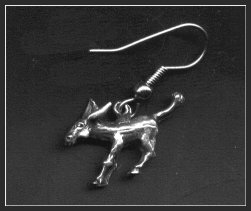 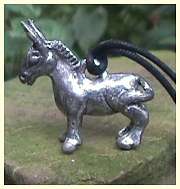 Earrings $12.00 plus 4.60 shipping
Pendant $12.00 plus 4.60 shipping
Handmade Donkey Jewelry from
3680 Panama-Stedman Road
Mayville, NY
14757
716-789-5804
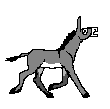 |
Donkey Bray
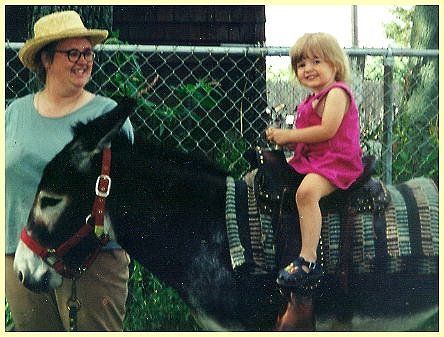
Sassafras Sam gives rides
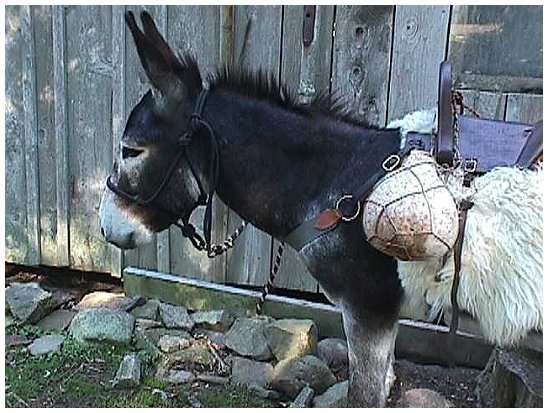
A classic!
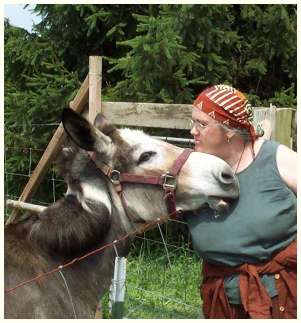
Foghorn Fern age 20 and Beth
Fern now belongs to Frank and Gail Seymour who live next door to us
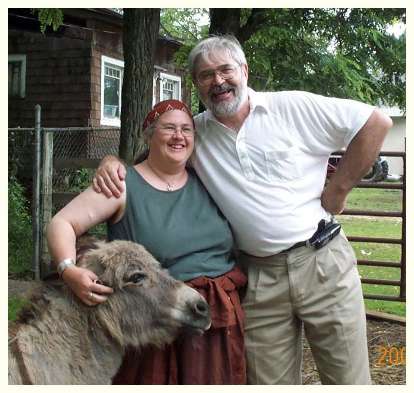
Willy, Beth, and friend, NickWhite
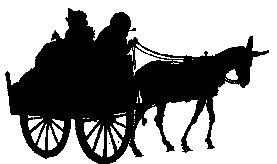
LINKS
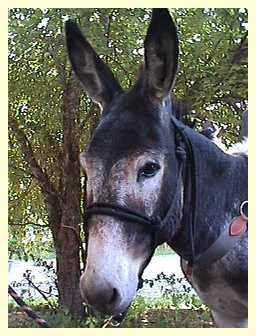
Come back soon!

copyright 2002 , Jim & Beth Boyle, All Rights Reserved
No part of this website may be used for any purpose ( including using images )
without written consent from The Rams Horn
